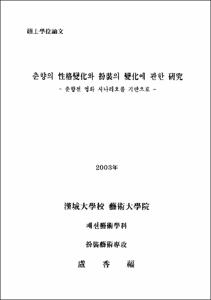춘향의 性格變化와 扮裝의 變化에 관한 硏究
= (The) Study to inquire into changes of the heroine Chunhyang's characters and the makeups
- Alternative Title
- 춘향전 영화 시나리오를 기반으로
- Abstract
- 「춘향전」은 민족고전으로서 오랜 세월 동안 다수의 생산자에 의해 창조된 개방적, 유동적, 적층적(積層的) 성격을 지닌 작품으로 현대에 와서는 영화로의 재창조 작업이 계속되고 있다.
본 연구에서는 시대가 바뀌어도 현재 진행형의 창조가 계속되어지고 그와 함께 항상 현재적 해석이 이루어지는 <춘향전> 영화 속에서 나타난 춘향의 성격변화와 외적 성격표현 수단인 분장의 변화, 배역배우의 이미지 변모 등을 고찰하고 계속해서 발전 승화 할 수 있는 가능성을 모색해 보는데 의의가 있다.
본 연구에서는 1923년 일본인 감독 햐야카와에 의해 제작된 영화 <춘향전>으로부터 2000년 임권택 감독의 <춘향뎐>에 이르기까지 총17편의 춘향전 영화 중에 연구자료가 될 시나리오나 비디오 테잎이 남아있는 1960년대 이후의 작품들 중에서 <춘향전> 영화사적으로도 의미가 있는 네 개의 작품을 선정하여 비교분석의 텍스트로 이용하였다.
선정된 영화 중 1961년 신상옥 감독의 <성춘향>과 1986년 한상훈 감독의 <성춘향> 2000년 임권택 감독의 <춘향뎐>은 시나리오를 기반으로 하고 비디오를 참조하여 분석하였으며 1976년 박태원 감독의 <성춘향전>은 비디오 테잎을 근거로 하여 분석하는 방법을 택하였다.
춘향의 성격변화와 분장의 변화에 대한 연구 결과는 다음과 같이 요약 할 수 있다.
1961년 <성춘향>에서 나타나는 춘향의 성격은 영화 전반에 걸쳐 시종 유교적 행동 규범에 의해 절제된 행동과 감정 표현으로 유순하고 조용하며 조신함을 잃지 않는 현모양처형의 모습으로 그려졌다.
1976년 <성춘향전>에서의 춘향은 풋풋한 소녀의 모습으로 별다른 수줍음 없이 적극적이며 발랄하고 날카로운 일면을 지닌 인물로 표현되었다.
1986년 <성춘향>에서 춘향은 유교적, 순종적 열녀상과 함께 성에대한 열정과 거칠게 욕하는 표독스러움 등 복합적인 성격을 나타내었다.
<원문누락>|The Tale of Chunhyang(The Chunhyangjeon) is a national classical literary work(a work of Korean classical literature) of exoteric, flexible and cumulative features, which was created by many producers(contributors) for a long time and has been newly interpreted in the process of being set to movies in recent decades.
It is significant for this study to inquire into changes of the heroine Chunhyang's characters, the makeups as an outward expressive way of her characteristics and the images of the cast, etc. in the cinematized Chunhyangjeons, whose ongoing recreation is continuously made and modern interpretation is always fulfilled as well through all the years, and to try seeking the possibility of its continuous advancement and sublimation. In this study, among 17 movies of the Chunhyangjeons in total from Japanese Director Hayakawa's "Chunhyangjeon" in 1923 to Director Im Kwon Taek's "Chunhyang" in 2000 since the 1960s, whose scenarios or video tapes are left to be used as source materials, four movies of importance in the history of the Korean cinema are chosen and employed as texts for a comparative analysis.
In the chosen films, Director Shin Sang Ok'sof 1961, Han Sang Hoon's of 1986 and Im Kwon Taek's of 2000 are analyzed by relying on the scenarios and referring to the videos, and an analytical method to use the video tape is adopted for Park Tae Won's of 1976.
The result of the study on the changes of the Chunhyang's characters and the makeups can be summarized as follows.
The Chunhyang's character inof 1961 was portrayed as a wise mother and good wife who always kept being obedient, quiet and circumspect with moderate behavior and emotional expression by the standard conduct of Confucianism throughout the whole movie.
Inof 1976, its Chunhyang had an image of a fresh girl and was described as an active, lively and quick witted character with little shyness.
Chunhyang inof 1986 was characterized as complex personality, who was a Confucian, obedient, virtuous woman and had a passion for sex and fierceness to speak harsh, etc.
In theof 2000, Chunhyang is not the image of a passive, spirit and expressing her feelings by the existing state of things, who has personality to ask for a pledge of not forgetting her face to face with Yi Doryeong in person, sexual openness based on true love, aggressiveness to Yi Doryeong's unilateral notification of parting and rash opposition against the unfair power, etc.
The cinematized Chunhyang's characters are, to some degree, two-faced and complex. Aspects of pure love, fidelity and resistance are generally shown in all the Chunhyangjeon movies. But in chronological order, the older visual products characterizes Chunhyang as a traditional, passive, virtuous woman of simple personality, but in the more recent movies the Confucian, virtuous woman but is described as a clever modern woman of character of the heroine changes and is portrayed as a rash, candid and passionate woman of multi-dimensional personality. This is resulted from active interpretation efforts of the original 「Chunhyangjeon」 in recent years and also reflects the spiritual world of the modemers. Thus, they keep step with the taste of modern audience, who more easily feel sympathy and identify themselves with multi-dimensional and modem character rather than simple and traditional one, and the trend of modern movies.
In addition, examining the Chunhyang's makeups, it is found that the heroines appeared in the chosen four films did not wear makeups in accordance with particularly changed characters as explained above, but they were just trying to present Chunhyang as a virtuous woman of beauty and supreme good. And the changes of makeup are also found to come from referring a great deal to the trend of the makeup at the time when the movies were made. The images of Chunhyang's role in company with these changes have undergone changes. In each film they keenly sensed the favorable image of the public with the times and then tried utilizing it in portraying Chunhyang's character in the movie.
Like this, the Chunhyang's characters, the makeup expression and the images of the heroines, etc. in the movies are influenced by changes in attitudes of scenarists and movie directors with the times and affected by fondness and inclination of the public in each age.
Therefore, these changes will be continuously advanced hereafter.
- Issued Date
- 2003
- Type
- Thesis
- Files in This Item:
-
-
Download
 000000066210.pdf
기타 데이터 / 3.41 MB / Adobe PDF
000000066210.pdf
기타 데이터 / 3.41 MB / Adobe PDF
-
Items in Repository are protected by copyright, with all rights reserved, unless otherwise indicated.